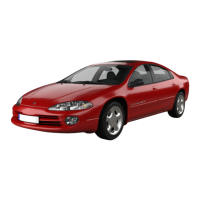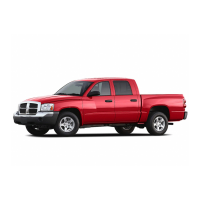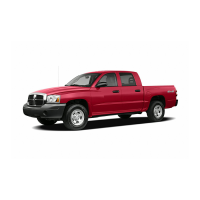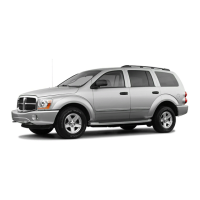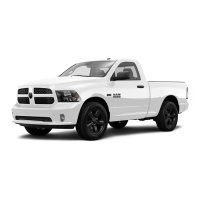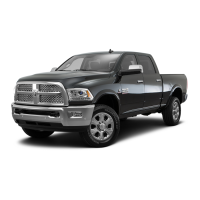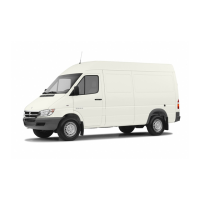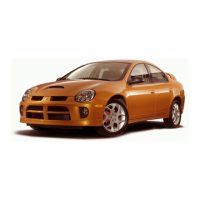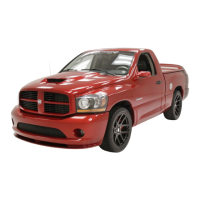PERFORMANCE TEST PROCEDURE
Before performing the following procedure, (Refer
to 24 - HEATING & AIR CONDITIONING/PLUMB-
ING - WARNING). Air temperature in test room and
in vehicle must be 21° C (70°F) minimum for this
test.
NOTE: When connecting the service equipment
coupling to the line fitting, verify that the valve of
the coupling is fully closed. This will reduce the
amount of effort required to make the connection.
(1) Connect a tachometer and manifold gauge set
or an A/C Charging/Recycling Station.
(2) Set controls:
MTC (Manual Temperature Control) System:
• A/C ON
• Panel Recirculation
• Temperature to full cold
• High blower
ATC (Automatic Temperature Control) System:
• Rotate blower knob to high position (full clock-
wise)
• Set temperature to the LO position
• Push panel mode button
• Push RECIRC (Recirculation) button (A/C and
RECIRC symbols should be lit)
NOTE: The word MANUAL should appear in the ATC
display, confirming that the system is set manually.
(3) Start engine and hold at 1000 rpm with A/C
clutch engaged.
(4) Engine should be warmed up with doors and
windows closed.
(5) Insert a thermometer in the left center A/C
outlet and operate the engine for five minutes. The
A/C clutch may cycle depending on ambient condi-
tions.
(6) With the A/C clutch engaged, compare the
discharge air temperature to the A/C Performance
Temperature table.
A/C PERFORMANCE TEMPERATURE AND PRESSURE
AMBIENT TEMPERATURE
21°C
(70°F)
26.5°C
(80°F)
32.5°C
(90°F)
37°C
(100°F)
43°C
(110°F)
MAXIMUM ALLOWABLE AIR
TEMPERATURE AT CENTER
LEFT PANEL OUTLET
6°C
(42°F)
7°C
(45°F)
10°C
(50°F)
12°C
(54°F)
15°C
(59°F)
COMPRESSOR
DISCHARGE PRESSURE
1379–1585
kPa
(200–230
psi)
1448–1723
kPa
(210–250
psi)
1654–1930
kPa
(240–280
psi)
1930–2206
kPa
(280–320
psi)
2206–2516
kPa
(320–365 psi)
COMPRESSOR SUCTION
PRESSURE
103–172 kPa
(15–25 psi)
139–208 kPa
(20–30 psi)
172–241 kPa
(25–35 psi)
208–276 kPa
(30–40 psi)
241–310 kPa
(35–45 psi)
DIAGNOSIS AND TESTING - HEATER
PERFORMANCE TEST
PRE-DIAGNOSTIC PREPARATIONS
Check the coolant level, drive belt tension, vacuum
line connections, electrical connections, radiator air
flow and fan operation. Start engine and allow to
warm up to normal temperature.
WARNING: DO NOT REMOVE RADIATOR CAP
WHEN ENGINE IS HOT, SEVERE PERSONAL
INJURY CAN RESULT.
If vehicle has been run recently, wait until engine
is cool before removing cap. Squeeze the radiator
hose to check temperature, and for pressure in the
system. If the hose is very firm, allow time to cool
down. Place a rag over the cap and turn it to the first
safety stop. Allow pressure to escape through the
overflow tube. When the system stabilizes, remove
the cap completely.
MAXIMUM HEATER OUTPUT: TEST AND ACTION
Engine coolant is provided to the heater system by
two 19 mm (3/4 inch inside diameter) heater hoses.
With engine idling at normal running temperature,
set the control to maximum heat, floor, and high
blower setting. Using a test thermometer, check the
air temperature coming from the floor outlets. Refer
to Temperature Reference Table.
24 - 2 HEATING & AIR CONDITIONING LH
HEATING & AIR CONDITIONING (Continued)
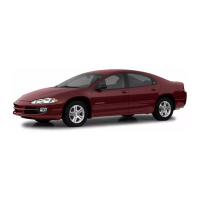
